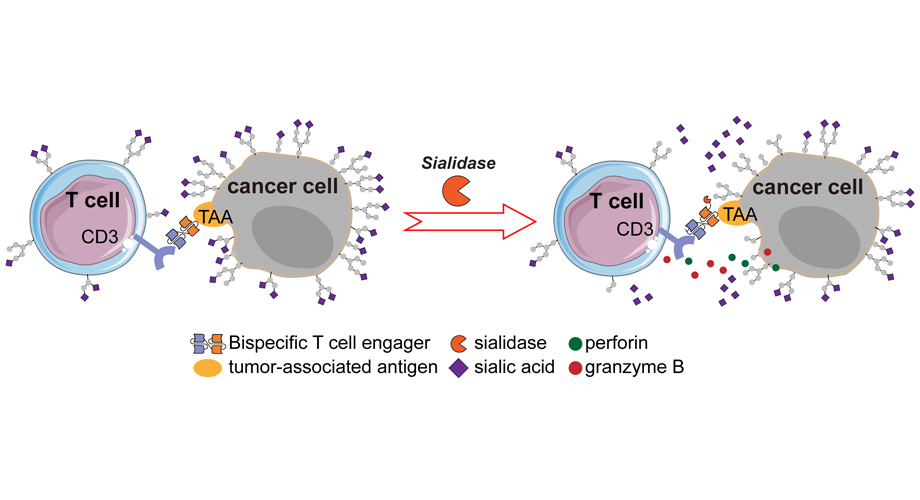
The Scripps Research team fused the enzyme sialidase onto bispecific T-cell engager (BiTE) molecules, helping break down the cancer cells’ outer barriers and thereby activating T cells against the cancer. Credit: Scripps Research
New technique improves T cell-based immunotherapies for solid tumors
Scripps Research scientists help T cells more effectively kill solid tumors cells in vitro and in mice by tweaking an existing cancer immunotherapy.
May 01, 2024
LA JOLLA, CA—Scientists from Scripps Research have enhanced an existing immunotherapy by removing the sugar coating surrounding solid tumors—such as in melanoma, breast, and prostate cancer—so T cells can more effectively kill tumor cells. They report in the journal Nature Biomedical Engineering on May 1, 2024, that this tweak allows T cells to get closer to their targets, which dramatically improves T-cell killing of tumor cells in mouse models.
Compared to blood tumors, solid tumors are resistant to treatment because they build a physical fort around themselves to block immune cells from entering and attacking. Part of this fort is made up of layers of sugar molecules, the outermost of which is a substance called sialic acid. To remove this sialic acid barrier, the research team fused the enzyme sialidase onto cancer therapy agents called bispecific T-cell engager (BiTE) molecules. These molecules typically work by activating a patient’s own T cells against the cancer.
“Solid tumors form a microenvironment around themselves that is immunosuppressive,” says senior author Peng Wu, PhD, a professor in the Department of Molecular Medicine at Scripps Research. “Immune cells have to enter this solid mass which is covered with sialic acid molecules that physically block T cells from infiltrating. The idea here is to introduce sialidase to the T-cell engager to chop off sialic acid from the outside of the tumor mass so that T cells have a better chance to enter.”
BiTE molecules have two binding sites — one that binds to molecules on tumor cell surfaces called antigens, and one that binds to the T-cell receptor complex. Several BiTE therapies are already FDA-approved, but they all target blood cancers (such as blinatumomab, which targets B-cell leukemia). However, clinical trials against solid tumors, which make up 90% of tumors, have had limited success.
“All of the approved drugs for T-cell engager molecules are against blood tumors, because all of the BiTE clinical trials against solid tumors have been pretty underwhelming,” says first author Zhuo Yang, PhD, who recently completed his PhD at Scripps Research under the guidance of Wu and the late Richard Lerner, MD. “We're really hoping the strategy that we present here may have the potential to make a breakthrough for T-cell engaging therapies against solid tumors.”
The researchers tested the fusion of sialidase to several different BiTE molecules targeting different types of cancer, including antigens associated with breast, B-cell and prostate cancers. In all cases, the addition of sialidase to create these "fusion molecules" improved T-cell killing in a lab dish (in vitro). In collaboration with Rutgers University, the research used fluorescent microscopy to show that these fusion molecules resulted in a much larger contact area (or “immunological synapse”) between T cells and the tumor cells that enables better tumor killing.
Next, the researchers tested the fusion molecule’s efficacy at treating solid tumors in mice. They found that mice that were treated with the fusion molecule had delayed tumor growth, smaller tumors, and were more likely to survive compared to mice treated with regular BiTE molecules. In one of the cancer models, treatment with the fusion molecule completely eradicated the tumors for two out of five mice.
The researchers also observed an altered microenvironment surrounding the tumor, which they credit with these improved treatment outcomes. “In the presence of the fusion molecule, we have better infiltration of T cells and natural killer cells, which are good cells for killing tumors, and less accumulation of immunosuppressive cells,” says Wu. “So basically, the fusion molecule can convert an immunosuppressive tumor microenvironment into a more immune-permissive one.”
Though the team hypothesized that adding sialidase would improve T-cell engagement, they were surprised by how much of a difference it made. “By simply cutting off one single sugar that's overexpressed on the surface of tumor cells, we can have huge enhancements,” says Yang. “There are many sugars on the surface of tumor cells and we’re only getting rid of the first layer, so we were not expecting to see such dramatic effects.”
Eventually, the researchers hope that their technology will help treat human cancer patients, but first they will need to engineer the molecules to make them more suitable for humans. They also hope to inspire more cancer researchers to consider sugars when designing therapeutics.
“Tumor cells have unique sugar patterns, but people rarely consider them,” says Wu. “We're hoping that in the future more and more people will think about sugars when they are designing therapeutic strategies.”
In addition to Wu and Yang, authors of the study, “Targeted desialylation and cytolysis of tumour cells by fusing a sialidase to a bispecific T-cell engager,” include Yingqin Hou, Geramie Grande, Chao Wang, Yujie Shi, Jaroslav Zak, Yue Wan, Ke Qin, John R. Teijaro, and the late Richard A. Lerner of Scripps Research; and Jong Hyun Cho and Dongfang Liu of Rutgers University-New Jersey Medical School.
This work was supported by the NIH and a Cancer Research Institute/Irvington postdoctoral fellowship.
For more information, contact press@scripps.edu

